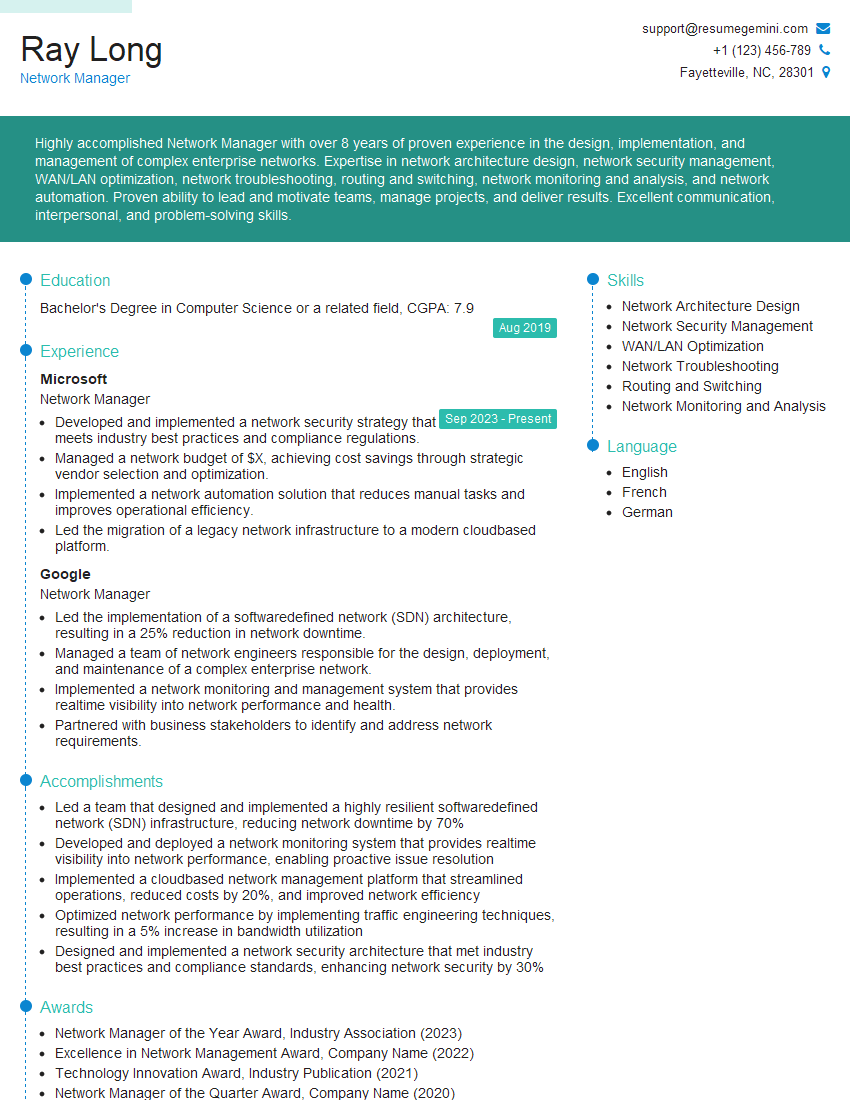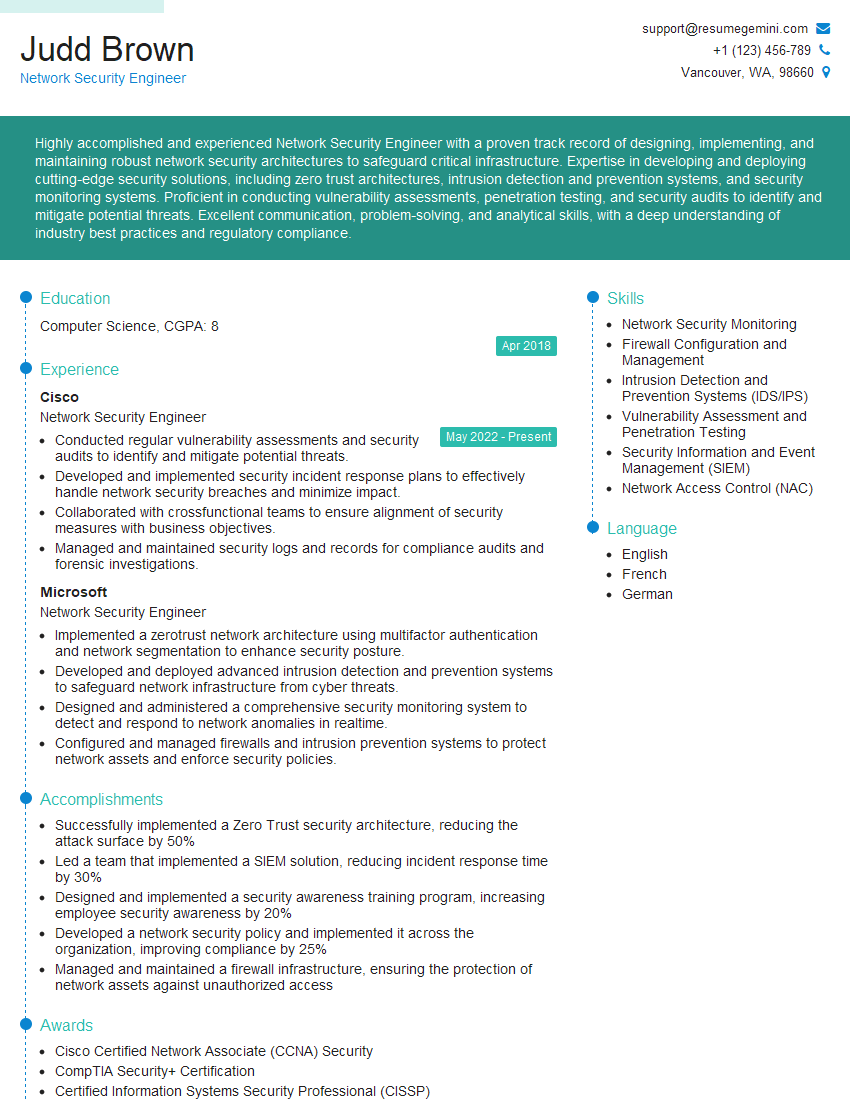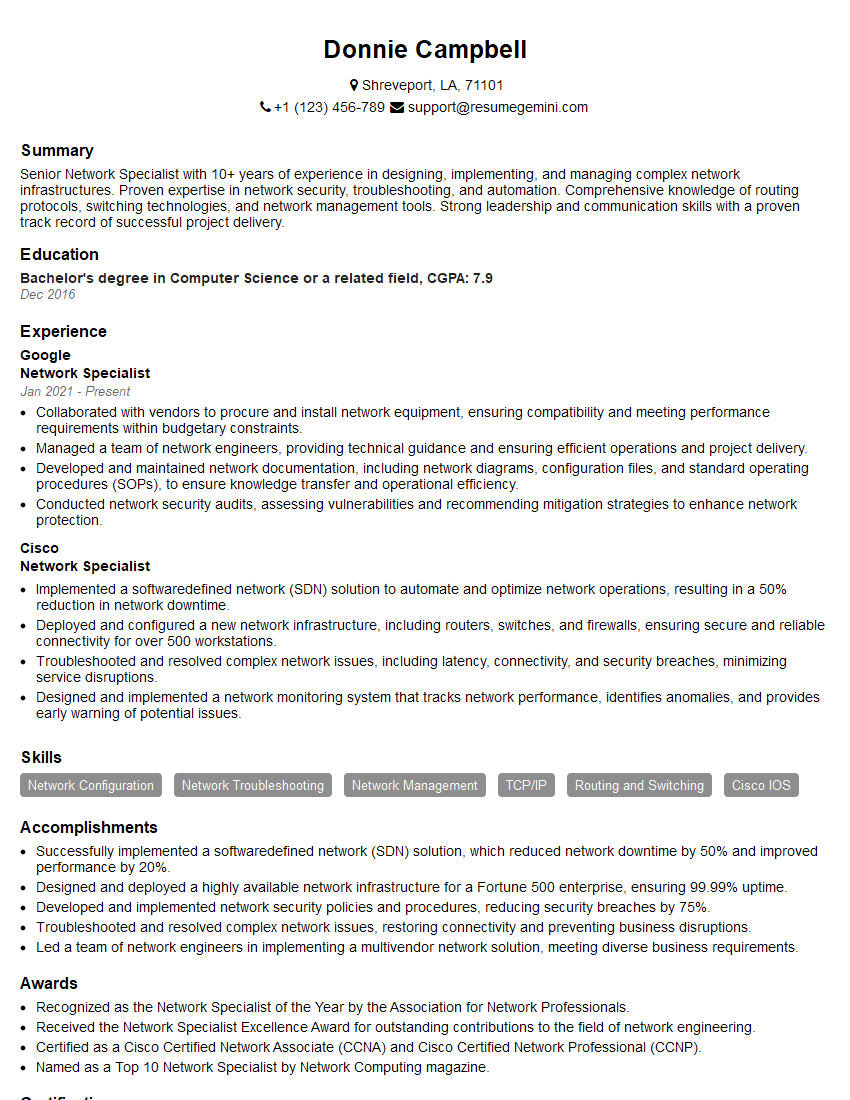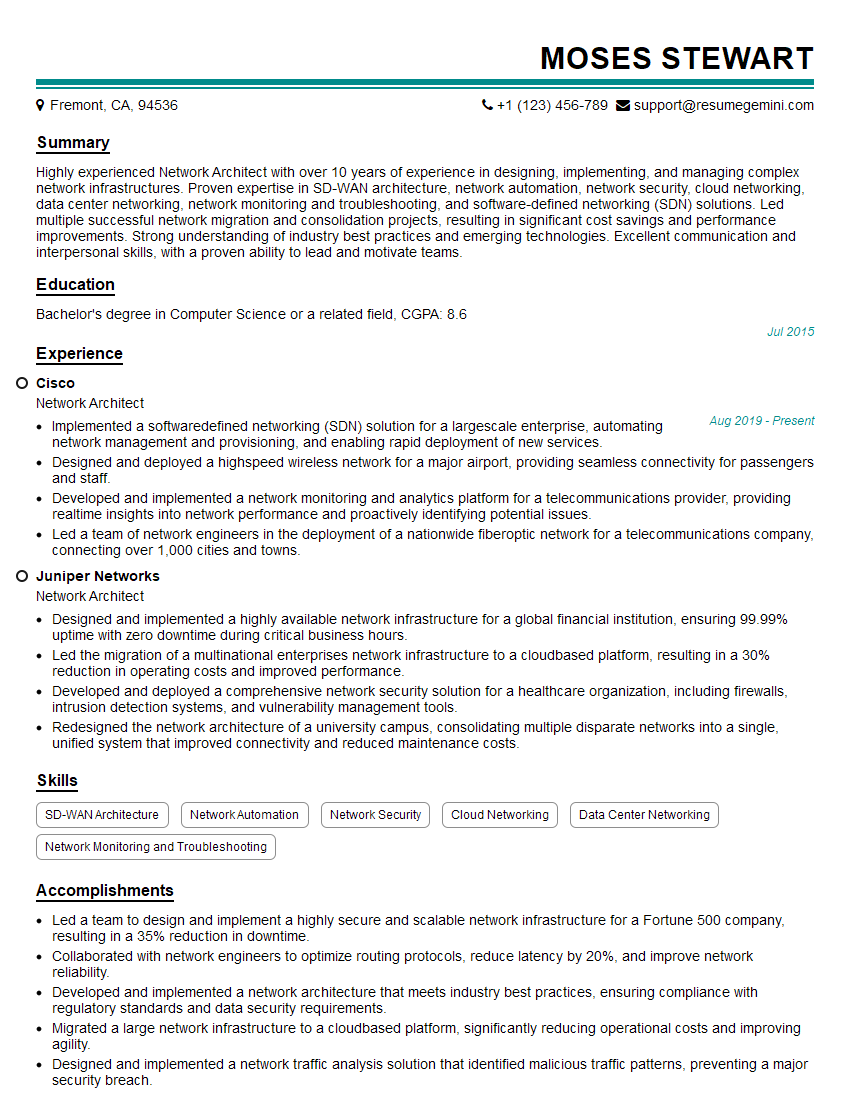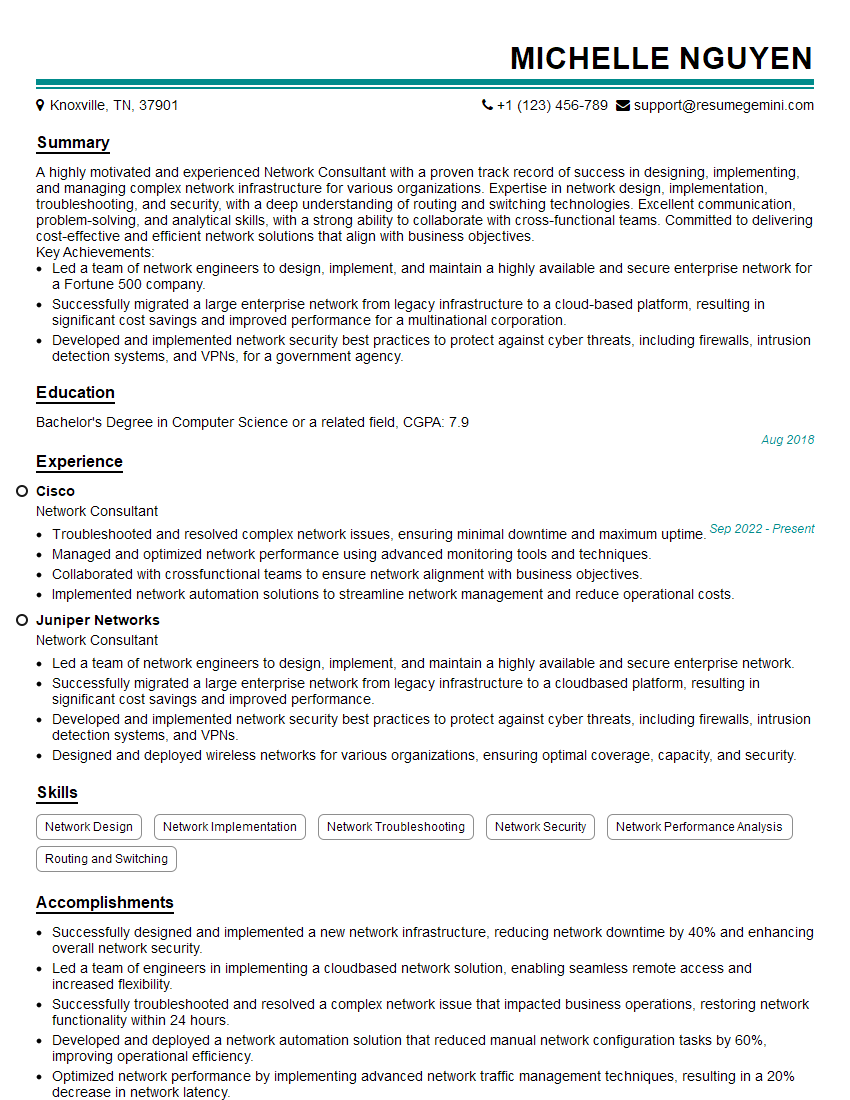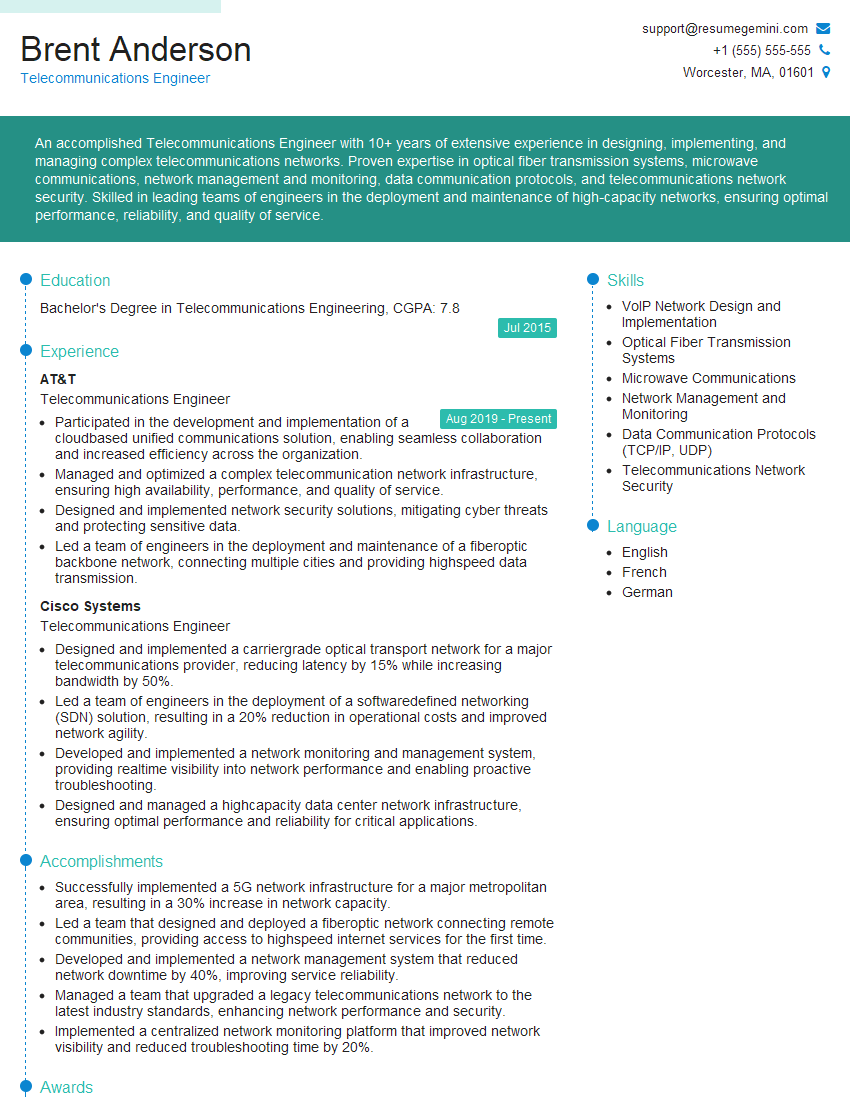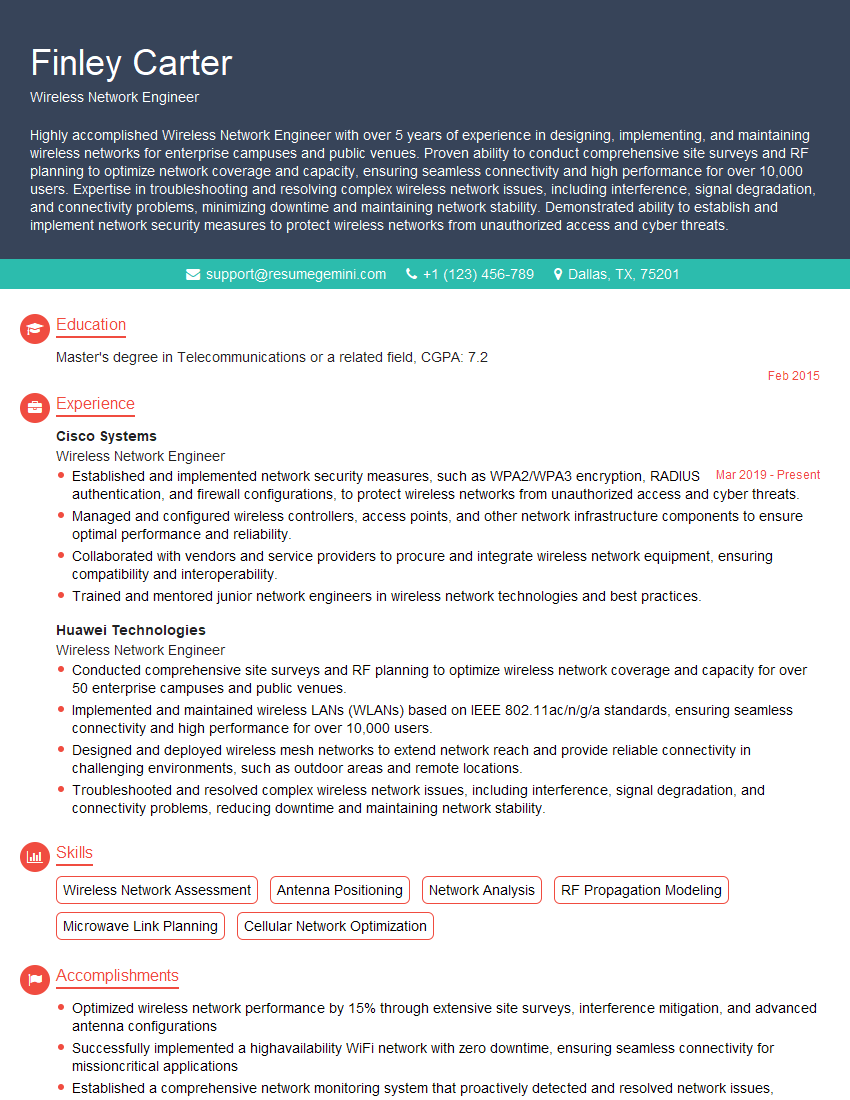The right preparation can turn an interview into an opportunity to showcase your expertise. This guide to LAN and WAN Design interview questions is your ultimate resource, providing key insights and tips to help you ace your responses and stand out as a top candidate.
Questions Asked in LAN and WAN Design Interview
Q 1. Explain the difference between LAN and WAN.
LAN, or Local Area Network, and WAN, or Wide Area Network, are both types of computer networks, but they differ significantly in their geographical scope and ownership.
A LAN connects devices within a limited geographical area, typically a single building or campus. Think of the network in your office, your home network, or the network connecting computers in a school. LANs are usually owned and managed by a single organization. They are characterized by high bandwidth and low latency, meaning data travels quickly and efficiently.
A WAN, on the other hand, spans a much larger geographical area, often connecting multiple LANs across cities, states, or even countries. The internet is the most prominent example of a WAN. WANs are usually owned and managed by multiple organizations and often involve leased lines or public internet connections. They generally have lower bandwidth and higher latency compared to LANs.
In short: LAN is local, owned by a single entity, high speed, low latency; WAN is wide-ranging, often shared ownership, lower speed, higher latency.
Q 2. Describe the OSI model and its layers.
The OSI (Open Systems Interconnection) model is a conceptual framework that standardizes the functions of a telecommunication or computing system without regard to its underlying internal structure and technology. It’s a seven-layer model, each layer performing a specific function:
- Layer 1: Physical Layer: Deals with the physical transmission of data, like cables, connectors, and network interfaces.
- Layer 2: Data Link Layer: Provides error-free transmission of data frames between two directly connected nodes, using technologies like Ethernet and MAC addresses.
- Layer 3: Network Layer: Responsible for routing data packets between networks, using IP addresses and routing protocols.
- Layer 4: Transport Layer: Provides reliable data transfer between applications, using protocols like TCP and UDP. It handles segmentation, reassembly, and error correction.
- Layer 5: Session Layer: Manages connections between applications, handling session establishment, management, and termination.
- Layer 6: Presentation Layer: Handles data formatting and encryption/decryption, ensuring data is presented correctly to the application.
- Layer 7: Application Layer: Provides network services to applications, such as email (SMTP), file transfer (FTP), and web browsing (HTTP).
Think of it as a stack of layers, each building upon the one below. Data travels down through the layers of the sender and back up through the layers of the receiver.
Q 3. What are the different types of network topologies?
Network topologies describe the physical or logical arrangement of nodes (computers, servers, etc.) and connections in a network. Common types include:
- Bus Topology: All devices are connected to a single cable (the bus). Simple but vulnerable to single points of failure.
- Star Topology: All devices connect to a central hub or switch. Common, easy to manage, and relatively robust.
- Ring Topology: Devices are connected in a closed loop. Data travels in one direction. Less common now.
- Mesh Topology: Multiple paths exist between devices, providing redundancy and high reliability. Complex and expensive to implement.
- Tree Topology: A hierarchical structure, often used in larger networks combining elements of star and bus topologies.
- Hybrid Topology: A combination of different topologies, offering flexibility and scalability.
The choice of topology depends on factors like network size, cost, performance requirements, and scalability.
Q 4. Explain the concept of subnetting and its importance.
Subnetting is the process of dividing a larger network (IP address range) into smaller, logical subnetworks. This improves network efficiency, security, and manageability.
Imagine a large apartment building. Without subnetting, all residents share the same network, creating potential congestion and security risks. Subnetting is like dividing the building into smaller sections (subnets), each with its own network. This allows for better organization and resource management.
Importance of Subnetting:
- Improved efficiency: Reduces network congestion by segmenting traffic.
- Enhanced security: Isolates subnets, limiting the impact of security breaches.
- Simplified management: Easier to manage and troubleshoot smaller networks.
- Conservation of IP addresses: Allows for more efficient use of available IP address space.
Subnetting involves using the subnet mask to determine the network address and host address within an IP address. For example, a subnet mask of 255.255.255.0 indicates that the first three octets define the network address, while the last octet represents the host address.
Q 5. How does routing work in a network?
Routing is the process by which data packets are forwarded from a source node to a destination node across multiple networks. Routers are responsible for making forwarding decisions based on routing tables, which contain information about networks and the best paths to reach them.
Think of it like a postal service. When you mail a letter, the postal service uses routing information (addresses) to determine the best path to deliver it to its destination. Similarly, routers use routing tables to determine the best path to forward data packets.
The process generally involves:
- Packet Arrival: A router receives a data packet with a destination IP address.
- Routing Table Lookup: The router consults its routing table to find the best path to the destination network.
- Forwarding Decision: Based on the routing table, the router decides on the next hop (the next router in the path).
- Packet Forwarding: The router forwards the packet to the next hop router.
- Repetition: This process is repeated until the packet reaches its final destination.
Q 6. What are the different routing protocols (e.g., OSPF, BGP)?
Many routing protocols exist, each with strengths and weaknesses. Some prominent examples are:
- OSPF (Open Shortest Path First): A link-state routing protocol used within autonomous systems (AS). It calculates the shortest path to destinations using Dijkstra’s algorithm and shares this information with other routers in the AS. Known for its scalability and efficiency.
- BGP (Border Gateway Protocol): A path-vector routing protocol used to exchange routing information between autonomous systems. It is the de facto standard for routing on the internet. BGP uses a more complex algorithm, exchanging routing information between different network providers.
- RIP (Routing Information Protocol): A distance-vector routing protocol that is simpler to implement than OSPF, but it doesn’t scale as well and has a limited hop count. Less common in modern networks.
- EIGRP (Enhanced Interior Gateway Routing Protocol): A Cisco proprietary distance-vector routing protocol that combines aspects of link-state and distance-vector protocols, offering robustness and scalability.
The choice of routing protocol depends on factors such as network size, complexity, and the need for scalability and redundancy.
Q 7. Explain the difference between static and dynamic routing.
Static and dynamic routing are two different approaches to configuring routing tables in a network:
Static Routing: The administrator manually configures the routing table entries. This is suitable for small, simple networks where routes rarely change. However, it doesn’t adapt to network changes and is not scalable for large networks.
Dynamic Routing: Routers automatically learn and adapt to changes in the network topology by exchanging routing information with other routers using routing protocols (like OSPF or BGP). This is more suitable for larger, complex networks, as it dynamically adapts to changes and requires less manual intervention. However, it increases network overhead due to the protocol exchanges.
In essence, static routing is like manually creating a map, while dynamic routing is like using a GPS navigation system that automatically updates based on traffic and road closures.
Q 8. What is VLAN and how does it improve network security?
A VLAN, or Virtual Local Area Network, is a logical grouping of devices on a physical network. Imagine a large office building: while all computers connect to the same physical network cabling, VLANs allow you to logically separate them into different broadcast domains, like departments or teams. This separation happens at the data link layer (Layer 2) of the OSI model using tagging mechanisms. Each packet is tagged with a VLAN ID, allowing switches to direct traffic only within the designated VLAN.
VLANs significantly improve network security by isolating different groups of devices. If one VLAN is compromised, the attack is contained within that VLAN, preventing it from spreading to other segments. For example, you could have a VLAN for guest Wi-Fi, another for finance, and yet another for marketing. A breach in the guest network won’t directly affect the sensitive financial data on a different VLAN.
For example, if a hacker gains access to a device in the guest VLAN, they cannot access the server resources residing on the finance VLAN. This isolation provides crucial security by limiting the impact of a security breach.
Q 9. Describe different network security measures.
Network security involves a multi-layered approach. Think of it as a castle with multiple defenses. Key measures include:
- Firewalls: Control network traffic based on pre-defined rules, acting as a barrier between your network and external threats. (Detailed in a later question)
- Intrusion Detection/Prevention Systems (IDS/IPS): Monitor network traffic for malicious activity, alerting administrators (IDS) or automatically blocking threats (IPS).
- Virtual Private Networks (VPNs): Create secure connections over public networks, encrypting data to protect confidentiality. (Detailed in a later question)
- Access Control Lists (ACLs): Define rules that specify which users or devices can access specific network resources. Think of it as a digital doorman controlling entry.
- Network Segmentation: Dividing the network into smaller, isolated segments to limit the impact of security breaches. (Detailed in a later question)
- Antivirus and Antimalware Software: Protect individual devices from malware and viruses.
- Regular Security Audits and Penetration Testing: Proactively identify vulnerabilities and assess the effectiveness of security measures.
- Strong Passwords and Authentication: Employ strong password policies and multi-factor authentication to prevent unauthorized access.
A comprehensive security strategy combines these measures to create a robust defense against various threats.
Q 10. Explain the concept of network segmentation.
Network segmentation divides a large network into smaller, more manageable segments. This is akin to dividing a large city into smaller neighborhoods, each with its own security and management considerations. Each segment has its own security policies and controls. If one segment is compromised, the others remain unaffected.
Benefits include improved security, enhanced performance through reduced network congestion, and simplified troubleshooting. For instance, a company might segment its network into separate VLANs for different departments (marketing, finance, HR), each with its own security protocols and access controls. If a malware infection occurs on a marketing computer, it’s less likely to affect the financial data.
Effective network segmentation often involves a combination of techniques, including VLANs, firewalls, and routing protocols to control traffic flow between segments.
Q 11. What are firewalls and how do they work?
A firewall is a network security device that monitors and controls incoming and outgoing network traffic based on a set of predefined security rules. Think of it as a gatekeeper that inspects everyone entering and leaving a building. It examines each packet of data and decides whether to allow or block it, based on factors such as source and destination IP addresses, ports, and protocols.
Firewalls typically operate at the network layer (Layer 3) and/or the transport layer (Layer 4) of the OSI model. They can be hardware devices (physical appliances) or software applications running on servers. They can be used to protect individual computers, local networks, or even entire organizations from unauthorized access and malicious traffic.
For instance, a firewall can be configured to block all incoming connections from untrusted IP addresses or block access to specific ports commonly used for malicious activities. This prevents unauthorized access and limits the impact of security breaches.
Q 12. What is QoS and why is it important?
QoS, or Quality of Service, is a set of networking technologies designed to prioritize certain types of network traffic over others. It’s like having different lanes on a highway; some lanes are for emergency vehicles (high-priority traffic), while others are for regular traffic. It ensures that critical applications receive the necessary bandwidth and resources, even during periods of high network congestion.
QoS is important because it improves the performance of critical applications that require low latency and high bandwidth, such as VoIP, video conferencing, and real-time data streaming. Without QoS, these applications might experience delays, jitter, or packet loss, negatively impacting the user experience. For example, in a hospital, QoS could prioritize medical imaging data transfer over less critical network traffic.
Q 13. Explain the concept of VPN and its applications.
A VPN, or Virtual Private Network, extends a private network across a public network, such as the internet. It creates a secure, encrypted connection, protecting your data from eavesdropping and unauthorized access. Imagine a secret tunnel through a crowded marketplace; only those with the right key can access the tunnel.
VPN applications include securing remote access to corporate networks, protecting online privacy when using public Wi-Fi, and bypassing geographical restrictions on content. For example, employees working remotely can securely connect to their company’s network using a VPN, allowing them to access internal resources as if they were in the office. Similarly, a user can encrypt their internet traffic using a VPN to protect their data from snooping.
Q 14. How does load balancing work in a network?
Load balancing distributes network traffic across multiple servers or devices, preventing any single server from becoming overloaded. Think of it like having multiple checkout lanes at a supermarket; customers are distributed among the lanes to prevent long queues at any one lane. This improves performance, reliability, and scalability of network services.
Several load balancing techniques exist, including round-robin (distributing requests sequentially), weighted round-robin (distributing requests based on server capacity), and least connections (directing requests to the least busy server). Load balancers can be hardware appliances or software applications. In a web server farm, for example, a load balancer distributes incoming requests to multiple web servers, preventing any one server from becoming a bottleneck and ensuring high availability.
Q 15. What is MPLS and its advantages?
MPLS, or Multiprotocol Label Switching, is a high-performance, scalable technology used to transfer data across a network. Think of it as a sophisticated highway system for your data packets. Instead of relying solely on IP addresses for routing (like using street addresses to navigate), MPLS uses labels – think of them as exit numbers on the highway – to quickly forward packets. This label-based forwarding significantly improves speed and efficiency.
- Advantages:
- Faster routing: Label switching is much faster than traditional IP routing because it bypasses complex routing table lookups. This is crucial for time-sensitive applications.
- Quality of Service (QoS): MPLS allows for prioritization of different types of traffic. For example, video conferencing can be given higher priority than email, ensuring smooth video calls even during periods of high network load.
- VPN capabilities: MPLS is commonly used to create Virtual Private Networks (VPNs), providing secure connections between geographically dispersed locations, ideal for businesses with multiple offices.
- Traffic engineering: MPLS allows for dynamic traffic management. Network administrators can adjust paths and bandwidth allocation to optimize network performance and avoid congestion.
Example: Imagine a large corporation with offices in New York, London, and Tokyo. MPLS would create a virtual private network, allowing seamless communication between these offices with enhanced security and performance compared to a simple internet connection.
Career Expert Tips:
- Ace those interviews! Prepare effectively by reviewing the Top 50 Most Common Interview Questions on ResumeGemini.
- Navigate your job search with confidence! Explore a wide range of Career Tips on ResumeGemini. Learn about common challenges and recommendations to overcome them.
- Craft the perfect resume! Master the Art of Resume Writing with ResumeGemini’s guide. Showcase your unique qualifications and achievements effectively.
- Don’t miss out on holiday savings! Build your dream resume with ResumeGemini’s ATS optimized templates.
Q 16. Explain the concept of network monitoring and troubleshooting.
Network monitoring and troubleshooting are crucial for ensuring network uptime and optimal performance. Monitoring involves continuously observing network traffic, device status, and application performance to identify potential issues before they impact users. Troubleshooting, on the other hand, is the process of diagnosing and resolving those issues once they occur.
Monitoring Tools: A range of tools like SolarWinds, Nagios, and PRTG can monitor various aspects of your network, including bandwidth utilization, CPU/memory usage on network devices, latency, and packet loss. These tools often provide dashboards showing real-time network status and historical data for analysis.
Troubleshooting Methodology: A systematic approach is key to effective troubleshooting. I typically follow these steps:
- Identify the problem: Pinpoint the specific issue. Is it affecting all users, or just some? Is the problem intermittent or constant?
- Gather information: Collect data from monitoring tools, user reports, and network device logs. This helps narrow down the possible causes.
- Isolate the cause: Use tools like ping, traceroute, and packet analyzers (Wireshark) to pinpoint the location of the fault.
- Implement a solution: Once the cause is identified, implement the necessary fix. This might involve reconfiguring a device, replacing faulty hardware, or resolving a software bug.
- Verify the solution: After implementing the fix, verify that the problem is resolved and that the network is functioning as expected.
- Document the process: Document the problem, troubleshooting steps, and solution for future reference.
Example: If users complain about slow internet speeds, I would first check bandwidth utilization using monitoring tools. If I find high bandwidth usage, I could investigate further to see which application is consuming the most bandwidth, perhaps identifying a resource leak. Then I could take action to optimize the network or the application.
Q 17. What are common network performance bottlenecks?
Network performance bottlenecks can occur at various points within the network infrastructure. They often manifest as slowdowns, latency issues, or even complete outages.
- Bandwidth limitations: Insufficient bandwidth is a common culprit, especially in environments with high traffic volumes. Upgrading to a higher bandwidth connection or optimizing network traffic can resolve this.
- Overloaded devices: Routers, switches, or servers can become overloaded if they need to process more traffic than their capacity allows. This can cause latency and packet loss. Upgrading to more powerful hardware or optimizing device configurations is crucial.
- Faulty hardware: Defective cables, network interface cards (NICs), or other hardware components can create bottlenecks. Regular maintenance and hardware replacements are essential.
- Inefficient routing protocols: Using outdated or inefficient routing protocols can increase latency and reduce network efficiency. Optimizing routing protocols or using more modern alternatives like BGP can improve performance.
- Software issues: Bugs in network operating systems, applications, or security software can lead to performance degradation. Regular software updates and patching are crucial.
- Congestion points: Particular network segments can experience higher congestion than others, leading to bottlenecks. Traffic engineering techniques can help redistribute traffic and alleviate congestion.
Example: In a small office, a slow internet connection could be due to insufficient bandwidth. Upgrading the internet plan would likely resolve the issue. In a large data center, a bottleneck might be caused by an overloaded switch, requiring the installation of a new, higher-capacity switch.
Q 18. Describe your experience with network design tools.
I have extensive experience with a variety of network design tools, including both open-source and commercial solutions. These tools are crucial for planning, designing, and simulating network architectures.
- Cisco Packet Tracer: This simulation tool is excellent for learning and designing smaller networks. It helps visualize network topologies and test configurations before implementing them in a real-world environment.
- GNS3: A more advanced network simulation tool that supports a wider range of devices and protocols. It’s ideal for complex network designs and simulations.
- SolarWinds Network Topology Mapper: This tool automatically discovers and maps the physical and logical topology of an existing network, providing valuable insights into network structure and connectivity.
- Visio/Draw.io: These diagramming tools are used for creating professional-looking network diagrams, essential for communication and documentation.
My experience extends beyond just using these tools; I can effectively leverage their capabilities to create efficient, scalable, and secure network designs, optimizing for performance and addressing potential future growth.
Q 19. How do you handle network outages or failures?
Handling network outages or failures requires a calm, methodical approach. My experience involves a combination of proactive measures and reactive responses.
Proactive Measures:
- Redundancy: Designing networks with redundant components, such as multiple routers, switches, and internet connections, ensures that if one component fails, the network can continue functioning. This includes failover mechanisms.
- Regular backups: Regularly backing up network configurations helps in quick restoration in case of failures.
- Monitoring and alerting: Implementing robust monitoring systems with alerts for critical events allows for prompt detection and response to issues.
Reactive Responses:
- Follow a troubleshooting process: Use a systematic approach to isolate the cause of the outage, as described in the previous answer.
- Escalate if necessary: If I am unable to resolve the issue, I escalate it to appropriate teams or vendors.
- Communicate with users: Keep users informed about the outage and the expected time to resolution.
- Post-incident analysis: After resolving the outage, conduct a thorough post-incident analysis to identify root causes and prevent future occurrences.
Example: In a previous role, a fiber cut caused a major network outage. Our redundancy plan immediately switched traffic to a backup connection, minimizing downtime. Following the outage, a post-incident review resulted in improved fiber route diversity for greater resilience.
Q 20. What are your experiences with different network hardware (routers, switches, etc.)?
My experience encompasses various network hardware, including routers, switches, firewalls, and load balancers from different vendors such as Cisco, Juniper, and Fortinet.
Routers: I’m familiar with configuring various routing protocols (BGP, OSPF, EIGRP) on both Cisco IOS and Juniper JunOS devices, optimizing routing tables for efficient network traffic flow. I also have experience with configuring advanced features like QoS and VPNs.
Switches: I’ve worked extensively with Layer 2 and Layer 3 switches, understanding VLANs, trunking, spanning-tree protocols, and port security. I have experience configuring and troubleshooting both managed and unmanaged switches from various vendors.
Firewalls: My experience includes configuring firewall rules, access control lists (ACLs), and implementing intrusion detection/prevention systems (IDS/IPS) to enhance network security.
Load Balancers: I’ve configured load balancers to distribute traffic across multiple servers, improving application availability and performance.
This hardware experience allows me to choose the right devices for a specific network design, optimizing for performance, security, and budget.
Q 21. Explain your understanding of TCP/IP model.
The TCP/IP model is a layered network architecture that governs how data is transmitted over a network. It’s a conceptual model, not a strict implementation, but it helps us understand the functionality of network communication. It’s commonly broken down into four layers, though it’s often discussed with a five layer breakdown, depending on the need for detail.
- Application Layer: This is where applications interact with the network. Protocols like HTTP (web browsing), SMTP (email), and FTP (file transfer) reside here. Think of it as the user interface to the network.
- Transport Layer: This layer is responsible for reliable data delivery. TCP (Transmission Control Protocol) provides reliable, ordered data transfer with error checking. UDP (User Datagram Protocol) is a faster, connectionless protocol that prioritizes speed over reliability – used for applications like streaming where minor packet loss is acceptable.
- Network Layer: This layer handles addressing and routing. IP (Internet Protocol) addresses each device on the network uniquely, enabling data packets to reach their destination. Routers operate at this layer.
- Data Link Layer: This layer deals with physical addressing (MAC addresses) and error detection on a local network. Ethernet is the most common protocol at this layer. Switches operate primarily at this layer.
- Physical Layer: This layer handles the physical transmission of data over the network media, such as cables or wireless signals. It’s the lowest level and is concerned with the physical hardware.
Example: When you browse a website, the application layer uses HTTP to request a web page. The transport layer (TCP) ensures that the request and response reach their destination reliably. The network layer (IP) routes the packets across the internet, and the data link layer handles the physical transmission over your local network and the internet infrastructure. The physical layer is the actual cable or wireless signal transmitting bits.
Q 22. Describe different network cabling types and their characteristics.
Network cabling is the backbone of any network, and choosing the right type is crucial for performance and reliability. Different cabling types offer varying bandwidth, distance capabilities, and cost considerations. Here are some key examples:
- Cat5e/Cat6/Cat6a: These are twisted-pair copper cables commonly used for Ethernet networks. Cat5e supports Gigabit Ethernet up to 100 meters, Cat6 supports 10 Gigabit Ethernet up to 55 meters, and Cat6a extends 10 Gigabit Ethernet to 100 meters. The higher the category number, the better the performance and shielding against interference. Think of it like upgrading from a standard highway to a high-speed toll road.
- Fiber Optic Cable: Fiber optic cables use light pulses to transmit data, offering significantly higher bandwidth and longer distances than copper cables. They’re immune to electromagnetic interference and are ideal for high-speed backbone networks and long-haul connections. Imagine this as a dedicated, super-fast train line compared to a highway.
- Coaxial Cable: Coaxial cables, while less common in modern LANs, are still used in some applications. They’re characterized by a central conductor surrounded by insulation and a shield, providing good protection against interference. Historically prevalent in cable television and early Ethernet networks.
The choice of cabling depends on factors like budget, required bandwidth, distance, and the environment. For instance, a small office might use Cat5e, while a data center requiring 40 Gigabit Ethernet would necessitate Cat6a or fiber.
Q 23. What is your experience with network documentation?
Comprehensive network documentation is paramount for efficient management and troubleshooting. My experience includes creating and maintaining documentation covering various aspects of network infrastructure, including:
- Network Diagrams: Detailed visual representations of network topology, including devices, connections, and IP addressing schemes (e.g., using Visio or similar tools).
- Device Inventories: A complete list of all network hardware, including vendor, model, serial number, location, and configuration details.
- IP Addressing Schemes: Documented IP address ranges, subnet masks, default gateways, and DNS server information.
- Standard Operating Procedures (SOPs): Step-by-step instructions for common network tasks such as adding new devices, troubleshooting connectivity issues, and performing backups.
- Security Policies: Documents outlining security measures, access control lists, and incident response procedures.
I strongly believe in using a collaborative approach to documentation, ensuring that everyone on the team has access to the most up-to-date information. This has proven invaluable in streamlining troubleshooting processes and facilitating smooth handoffs between team members.
Q 24. How do you ensure network security in a cloud environment?
Securing a network in a cloud environment requires a multi-layered approach combining cloud-native security features with best practices for traditional network security. This involves:
- Identity and Access Management (IAM): Implementing strong password policies, multi-factor authentication (MFA), and granular access controls to limit who can access specific resources.
- Virtual Private Clouds (VPCs): Creating isolated virtual networks within the cloud provider’s infrastructure to enhance security and segmentation.
- Security Groups and Network Access Control Lists (ACLs): Configuring firewalls to control inbound and outbound traffic based on IP addresses, ports, and protocols.
- Data Encryption: Encrypting data at rest and in transit using encryption protocols like TLS/SSL and AES to protect sensitive information.
- Intrusion Detection/Prevention Systems (IDS/IPS): Deploying IDS/IPS solutions to monitor network traffic for malicious activity and automatically block or alert on suspicious patterns.
- Regular Security Audits and Penetration Testing: Conducting regular security assessments to identify vulnerabilities and weaknesses in the network’s security posture.
Regular security patching and updates are also vital to maintain a robust security posture. This proactive approach minimizes the attack surface and reduces vulnerabilities that could be exploited by malicious actors.
Q 25. Explain your understanding of network capacity planning.
Network capacity planning is the process of forecasting future network requirements and ensuring the network infrastructure can handle the expected growth in users, devices, and bandwidth demands. It’s a proactive approach to avoid performance bottlenecks and service disruptions.
The process typically involves:
- Forecasting future needs: Analyzing historical data, business plans, and application requirements to estimate future network traffic and bandwidth consumption.
- Assessing current capacity: Evaluating the current network’s performance, identifying bottlenecks, and measuring resource utilization.
- Designing for scalability: Choosing network hardware and architecture that can be easily scaled to meet future demands. This often involves adopting modular designs and utilizing virtualization.
- Monitoring and optimization: Continuously monitoring network performance and making adjustments to ensure optimal capacity utilization.
For example, a company expecting significant growth might need to upgrade its network switches and routers to higher capacities, increase bandwidth, and implement QoS policies to prioritize critical applications. Without proper capacity planning, the network could become congested, leading to slowdowns, dropped connections, and ultimately affecting business productivity.
Q 26. What is your experience with network automation tools?
I have extensive experience with various network automation tools, including:
- Ansible: Used for automating configuration management, provisioning, and deployment of network devices. I’ve leveraged Ansible to automate tasks such as configuring routers, switches, and firewalls, ensuring consistent configurations across the network.
- Puppet/Chef: Similar to Ansible, these tools enable infrastructure as code (IaC), allowing for repeatable and version-controlled network configurations.
- Python with Netmiko/Paramiko: Programmatic control of network devices through scripting. This allows for automating complex tasks and integrating with other systems for monitoring and reporting.
- Network Programmability APIs (e.g., RESTCONF, NETCONF): Leveraging APIs to directly interact with network devices for automated configuration and monitoring. This is especially valuable in large-scale deployments.
Automation has significantly improved efficiency and reduced human error in network management. It allows for faster deployments, reduced downtime, and improved consistency in network configurations across the organization. For example, I used Ansible to automate the deployment of new switches to our data center, reducing deployment time from days to hours, while minimizing the risk of misconfiguration.
Q 27. Describe your experience with SD-WAN technologies.
SD-WAN (Software-Defined Wide Area Network) technology offers a flexible and efficient way to manage and optimize wide area networks. My experience includes designing, implementing, and managing SD-WAN solutions using various vendors’ platforms.
Key benefits of SD-WAN that I’ve leveraged include:
- Centralized management: A single pane of glass for managing the entire WAN, simplifying administration and troubleshooting.
- Application-aware routing: Directing traffic based on application requirements, ensuring optimal performance for critical applications.
- Dynamic path selection: Automatically selecting the best path for traffic based on factors like bandwidth, latency, and packet loss.
- Cost optimization: Utilizing various transport options (e.g., MPLS, broadband internet) to optimize bandwidth costs.
- Enhanced security: Integrating security features such as firewalls, VPNs, and intrusion prevention systems into the SD-WAN architecture.
In a recent project, I implemented an SD-WAN solution for a geographically dispersed company, improving network performance and reducing WAN costs by over 30% by intelligently leveraging multiple internet connections and prioritizing critical business applications.
Q 28. Explain your experience with network virtualization.
Network virtualization allows for the creation of virtual network functions (VNFs) and virtual networks, decoupling network functions from dedicated hardware. My experience involves utilizing technologies like:
- Virtual Switches (vSwitches): Creating virtual switches within hypervisors to connect virtual machines (VMs) and provide network connectivity.
- Network Virtualization Platforms (NVFs): Deploying software-defined networking (SDN) controllers and virtual routers/switches to manage and control virtual networks.
- Virtual Network Functions (VNFs): Deploying virtualized network functions such as firewalls, load balancers, and VPN gateways as software applications, reducing hardware costs and increasing flexibility.
- Overlay Networks: Creating virtual networks on top of existing physical networks, allowing for greater flexibility and isolation of virtualized workloads.
Network virtualization provides increased agility, scalability, and cost savings. For example, I implemented a virtualized data center using VMware NSX, allowing for rapid deployment of new VMs and improved resource utilization. This also simplified network management and enhanced security through micro-segmentation of virtual networks.
Key Topics to Learn for LAN and WAN Design Interview
- Network Topologies: Understanding different network topologies (bus, star, ring, mesh) and their strengths and weaknesses in LAN and WAN environments. Consider practical applications like choosing the right topology for a small office versus a large enterprise.
- IP Addressing and Subnetting: Mastering IP addressing schemes (IPv4, IPv6), subnetting, and VLSM for efficient IP address allocation in both LAN and WAN networks. Be prepared to solve practical subnetting problems.
- Routing Protocols: Familiarize yourself with common routing protocols like RIP, OSPF, BGP, and their functionalities. Understand how they work in different network scenarios and their role in WAN connectivity.
- Network Security: Explore key security concepts such as firewalls, intrusion detection/prevention systems, VPNs, and access control lists (ACLs) and their application in securing LANs and WANs.
- Wireless Networking (WLAN): Understand the fundamentals of wireless technologies like 802.11 standards, access point configuration, security protocols (WPA2/3), and potential challenges in WLAN design.
- Network Performance and Monitoring: Learn about methods for monitoring network performance, troubleshooting common issues, and optimizing network efficiency using tools and techniques.
- WAN Technologies: Explore various WAN technologies like MPLS, Frame Relay, ATM, and their applications in building wide-area networks. Consider the trade-offs between cost, performance, and scalability.
- Network Design Principles: Understand key principles like scalability, redundancy, security, and manageability when designing LAN and WAN architectures. Be prepared to discuss how these principles are applied in practice.
Next Steps
Mastering LAN and WAN design is crucial for career advancement in networking and opens doors to exciting opportunities in various industries. An ATS-friendly resume is your first impression on potential employers. To significantly increase your chances of landing your dream job, focus on crafting a compelling resume that highlights your skills and experience effectively. ResumeGemini is a trusted resource to help you build a professional and impactful resume. Examples of resumes tailored specifically for LAN and WAN Design professionals are available to help guide you. Take the next step towards your successful career today!
Explore more articles
Users Rating of Our Blogs
Share Your Experience
We value your feedback! Please rate our content and share your thoughts (optional).
What Readers Say About Our Blog
Hi, I’m Jay, we have a few potential clients that are interested in your services, thought you might be a good fit. I’d love to talk about the details, when do you have time to talk?
Best,
Jay
Founder | CEO
